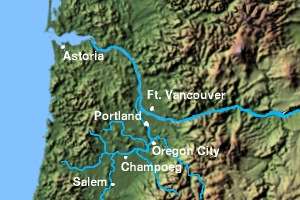Fort Vancouver
|
Fort Vancouver National Historic Site | |
|
Location of Fort Vancouver | |
 | |
| Location | Vancouver, Washington, United States |
|---|---|
| Built | 1824 |
| NRHP Reference # | 66000370[1] |
| Added to NRHP | October 15, 1966 |
Fort Vancouver was a 19th-century fur trading outpost along the Columbia River that served as the headquarters of the Hudson's Bay Company's Columbia Department, located in the Oregon Country. Named for Captain George Vancouver, the fort was located on the northern bank of the Columbia River in present-day Vancouver, Washington. Today, a full-scale replica of the fort, with internal buildings, has been constructed and is open to the public as Fort Vancouver National Historic Site.
History
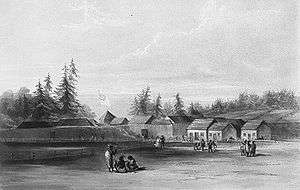
Joint occupation
The outpost was established in the winter of 1824–1825.[2] At that time, the region known as the Columbia District of the Hudson's Bay Company, and increasingly as the Oregon Country to Americans, was jointly occupied by the United States and Britain; a situation agreed to in the Anglo-American Convention of 1818. British interests were represented by the Hudson's Bay Company, which had exclusive trading rights to most of the land that is now Western Canada. To protect their interests north of the Columbia River, they sought to set up a headquarters somewhere along the northern bank that would secure the area and act as the hub for their fur trading in the Pacific Northwest; replacing Fort George (Fort Astoria) in that capacity as it was on the river's south bank and not as convenient to the inland trade.
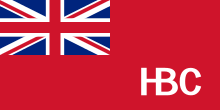
Sir George Simpson was instrumental in establishing the fort, and Chief Factor Dr. John McLoughlin was its first manager, a position he held for nearly 22 years, from 1824 to 1845.[3] James Douglas spent nineteen years in Fort Vancouver; serving as a clerk until 1834 when he was promoted to the rank of Chief Trader. From October 1838 to November 1839, while McLoughlin was on furlough in Europe, Chief Trader Douglas was in charge. In November 1839 Douglas was promoted to the rank of Chief Factor. Douglas took on several temporary assignments elsewhere, to set up HBC's trading post at Yerba Buena (San Francisco) California in 1841, and to establish Fort Victoria in 1843, but from 1839 to 1845 there were normally two Chief Factors based at Fort Vancouver, with McLoughlin in charge and Douglas as his subordinate.[4]
McLoughlin was later hailed as the Father of Oregon. Against the Company's wishes, he provided substantial aid and assistance to westbound Americans settlers in the territory. He left the company in 1846 to found Oregon City in the Willamette Valley.
When Simpson chose the fort's location, the lower Columbia River was becoming the de facto boundary between British and U.S. interests. The site he selected, on the opposite side of the Columbia River from the mouth of the Willamette River, was flat and had easy access to the Columbia, yet was just outside the flood plain.
The site was also picked because of the access to fertile farmland. Simpson wanted the fort to be self-sufficient, as food was costly to ship. In time Fort Vancouver produced a surplus of food, some of which was used to provision other HBC posts and some of which was exported for sale in Hawaii, Russian Alaska, and other markets. The area around the fort was commonly known as "La Jolie Prairie" (the pretty prairie) or Belle Vue Point ("beautiful vista").
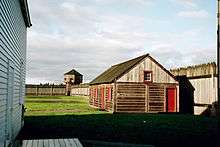
The fort was supplied by ships from the Pacific and by the overland York Factory Express trade route, which evolved from an earlier express brigade used by the North West Company between Fort George (originally Fort Astoria, founded in 1811 by John Jacob Astor's American Fur Company), at the mouth of the Columbia River, to Fort William on Lake Superior.[5]
Following the forced merger of the North West Company and the Hudson's Bay Company in 1821; the British Parliament imposed the laws of Upper Canada on British subjects in the Columbia District and Rupert's Land and gave the authority to enforce the laws to the Hudson's Bay Company. Chief Factor John McLoughlin applied the law to British subjects, kept peace with the natives and sought to maintain law and order amongst American settlers as well.

Express
By 1825, there were usually two York Factory Express brigades, each setting out from opposite ends of the route. Each spring, one left from Fort Vancouver and the other from York Factory on Hudson Bay. They passed each other in the middle of the continent. Each brigade consisted of about forty to seventy five men and two to five specially made bateaux.
Compared to other travellers of the time, they travelled quickly—an 1839 report cites the travel time as three months and ten days—almost 26 miles (40 km) per day on average.[5] These men carried supplies in and furs out by boat, horseback and as back packs for the forts and trading posts along the route. They also carried status reports for supplies needed, furs traded, etc., to and from Dr. John McLoughlin and the other fort managers along the route.
The practice of using bateaux (boats) was adopted because birch bark canoes had proved too dangerous on the rivers of the Pacific Northwest. The bateaux were similar to the York boats used on the Saskatchewan River but smaller and with other adaptions for the rigors of the Columbia. In 1820, Joe McKay of the HBC described the Columbia District bateaux as "made from quarter-inch pine board, and are thirty-two feet long, and six and a half feet wide in midships, with both ends sharp, and without a keel—worked, according to the circumstances of the navigation, with paddles, or with oars."[6] Indians along the way were often paid in trade goods to help them portage around falls and unnavigable rapids.
From west to east, Fort Vancouver to York Factory, the express route ran as follows: up the Columbia River past the posts of Fort Nez Perces, Fort Okanogan, and Fort Colvile to Boat Encampment (today under Kinbasket Lake), then over Athabasca Pass to Jasper House, down the Athabasca River to Fort Assiniboine, then overland to Fort Edmonton. Thence down the North Saskatchewan River and Saskatchewan River to Lake Winnipeg and via Norway House on the Nelson River. Finally the brigade would travel down the Hayes River to York Factory on Hudson Bay.[7][8] This route was longer than the Oregon Trail route followed by the Americans, but easier.
Ships
The trade goods, supplies and mail which were moved overland in this manner, were brought into Fort Vancouver and York Factory by ship every year (they tried to maintain one year's extra supplies to avoid disastrous ship wrecks, etc.). The furs they had traded for blankets, tobacco and manufactured goods were shipped back on the supply ships. Furs from Fort Vancouver were often being shipped to China where they were traded for Chinese goods before returning to England, with the furs from York Factory being sold in London in an annual fur sale. This continued until 1846, when the land on which the fort was located changed from British to American ownership.
Fort
The fort was substantial. The palisades that protected it were 750 feet (230 m) long, 450 feet (140 m) wide and about 20 feet (6.1 m) high. Inside there were 40 buildings, including housing, warehouses, a school, a library, a pharmacy, a chapel, a blacksmith, plus a large manufacturing facility. Outside the ramparts there was additional housing, as well as fields, gardens, fruit orchards, a shipyard, a distillery, a tannery, a sawmill, and a dairy. The residential village, populated by employees, their families, and others, was known as Kanaka Village because of the many Hawaiians in company employ who lived there. Fort Vancouver was by far the largest settlement of non-natives west of the Great Plains at this time. The populace of the fort and the surrounding area were mostly French-Canadians and Metis; there were also English, Scots, Irish, Hawaiians and a large variety of Native Americans including Iroquois and Cree. The common language spoken at the fort was Canadian French. However trading and relations with the surrounding community were done in Chinook Jargon, a pidgin of Chinook, Nootka, Chehalis, English, French, Hawaiian and other elements. Company records and official journals were kept in English, however, and English was used at the head table.

The fort was the center of activity in the Pacific Northwest. Every year, ships and supplies from London arrived, directly via the Pacific Ocean, and overland via Hudson Bay. Supplies and trade goods were exchanged for the furs. Fort Vancouver was the nexus for the fur trade on the Pacific Coast and its influence reached from the Rocky Mountains to the Hawaiian Islands, and from Alaska into Mexican-controlled California.
Over time, Fort Vancouver diversified its economic activity and began exporting agricultural foodstuffs from HBC farms, along with salmon, lumber, and other products. It developed markets for these exports in Russian Alaska, Hawaii, and Mexican California. The HBC opened agencies in Sitka, Honolulu, and Yerba Buena (San Francisco) to facilitate such trade.[9] At its pinnacle, Fort Vancouver watched over 34 outposts, 24 ports, six ships, and 600 employees.

Americans
The Hudson's Bay Company, which controlled the fur trade in much of what Americans styled the Oregon Country, had previously discouraged settlement because it interfered with the lucrative fur trade. By 1838, however, American settlers were coming across the Rocky Mountains and their numbers increased each subsequent year. Many left from St. Louis, Missouri and followed a fairly straight, but difficult, route called the Oregon Trail. For many settlers the fort became the last stop on the Oregon Trail where they could get supplies before starting their homestead.
During the Great Migration of 1843 an estimated 700 to 1,000 American settlers arrived via the Oregon Trail.
British response
Belatedly realizing that settlement would eventually decide the Oregon question, Simpson established the Puget Sound Agricultural Company around 1840 as a subsidiary of the Hudson's Bay Company. The purpose of the company was ostensibly to promote settlement by British subjects of land on the Pacific coast of North America. Company operations were centered at Fort Nisqually, located in current day DuPont, Washington (near Olympia, WA), where the company developed dairy, livestock and produce farms.
Sir George Simpson then instructed Alexander Ross to organize and lead a party of Red River Colony settlers over the Rockies into the Columbia District, to settle on the HBC farms. Ross, fearing he was getting too old for such an arduous journey, selected James Sinclair for the task.
In 1841, James Sinclair guided a large party of settlers from the Red River Colony west in an attempt to retain the Columbia District for Britain. They left Fort Garry, now the city of Winnipeg, in 1841 with 129 people consisting of 23 families, including a 75-year-old woman, with an aim to settle in the Oregon Country to reinforce British claims to the area. The British trappers, traders and settlers followed the Red River north, then crossed Lake Winnipeg and followed the Saskatchewan River system to Fort Edmonton. After a brief stop at Fort Edmonton, they were guided by Maskepetoon, the chief of the Wetaskiwin Cree, via Lake Minnewanka to the present site of Banff, Alberta where the Spray River joins with the Bow River; and then south up the Spray River valley where the reservoir now lies. They then trekked along a tributary, Whiteman's Creek, and crossed the Great Divide of the Rocky Mountains, by a new route which became known as Whiteman's Pass. From the summit, they traveled southwest down the Cross River to it junction with the Kootenay River. They entered the upper Columbia River basin via Sinclair Pass (near present-day Radium Hot Springs) and followed established trade routes from Lake Windermere, B.C. to Fort Vancouver. Despite the hardship, no one died and a baby was born on the way. When the Sinclair settlers arrived, McLoughlin was slow to settle them on Pugets Sound Agricultural Company farms. Instead he encouraged them to settle in the Willamette Valley, with the American settlers, where they could get free land.
In 1846, McLoughlin resigned from service with the Hudson's Bay Company for a homestead of his own. He founded Oregon City in the Willamette Valley. That same year, the Oregon Treaty set the Canada–United States border at the 49th parallel north, and Fort Vancouver was now within American territory. Although the treaty ensured that the Hudson's Bay Company could continue to operate and had free access to navigate the Strait of Juan de Fuca, Puget Sound, and the Columbia, company operations were effectively stifled by the treaty and became unprofitable and were soon closed down.
Fort Vancouver and Fort Columbia
Early history
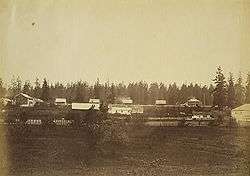
In 1849, the U.S. Army set up the Columbia Barracks (later renamed Vancouver Barracks) 45°37′32″N 122°39′55″W / 45.62556°N 122.66528°W on a rise 20 feet (6 m) above the trading post, fronting 1,200 yards (1100 m) on the river with buildings on a line 2,000 yards (1800 m) from the water.
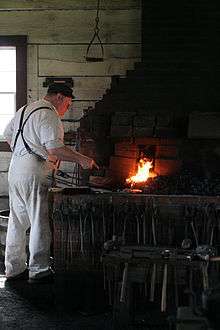
While the Hudson's Bay Company continued to operate out of Fort Vancouver, every year saw less and less fur trade and more and more settlers and U.S. Army warfare against the HBC's former customer base. During this time the Indian Wars were happening in the west and famous military men such as Ulysses S. Grant, Philip Henry Sheridan, O.O. Howard, C.E.S. Wood, Arthur MacArthur, Jr., and George Crook were stationed at the fort at various times. Around October, 1852, Benjamin Bonneville arrived with orders to set up a permanent military reservation which encompassed not only the barracks but the Hudson Bay fort.[10] Finally, on June 14, 1860, the Hudson's Bay Company abandoned Fort Vancouver and moved its operations north of the border. The U.S. Army immediately renamed the combined location Fort Columbia, changing the name again to Fort Vancouver. They used it for quarters and storage, with its local population fluctuating seasonally, with the lowest strength being 50 people in 1861. During the American Civil War, detachments of the 1st Washington Territory Infantry Volunteers and 1st Oregon Cavalry were stationed here. In 1866, most of the fort burned down in a large fire.
Fort Vancouver was rebuilt, with a layout that included two double-story barracks on opposite sides of the parade ground, each with a kitchen and mess room to the rear. Seven log and four frame buildings served as officer's quarters.
20th and 21st centuries
The post remained in active service, being expanded for World War I into Vancouver Barracks. During World War I it was the home of the Army's Spruce Production Division under the command of Colonel Brice Disque.[11] In the interwar years, the 5th Infantry Brigade was based there and from 1936 to 1938, it was commanded by future Army Chief of Staff George C. Marshall. In World War II when Vancouver Barracks was used as a staging area for the Seattle Port of Embarkation, the post included 3,019 acres (12.22 km2), and had billeting space for 250 officers and 7,295 enlisted persons. After WWII, Vancouver Barracks became a sub-installation of Fort Lewis and maintained a small contingent of active duty troops. The majority of billeting space was transformed into military offices and became home for Army Reserve and Washington National Guard troops during this time as well. It was forced to close (under the BRAC commission) in the summer of 2011. A 2012 Memorial Day ceremony saw the south and east barracks officially turned over to the care of the National Park Service.[12]
Because of its significance in United States history a plan was put together to preserve the location. Fort Vancouver was declared a U.S. National Monument on June 19, 1948, and redesignated as Fort Vancouver National Historic Site on June 30, 1961. This was taken a step further in 1996 when a 366-acre (1.48 km2) area around the fort, including Kanaka Village, the Columbia Barracks and the bank of the river, was established as the Vancouver National Historic Reserve maintained by the National Park Service. It is possible to tour the fort. It is also the site of a large fireworks display, said to be the largest 4 July display west of the Mississippi River, lasting for 31 minutes and featuring 5,440 shells in 2008.[13]
An earth-covered pedestrian land bridge was built over the Lewis and Clark Highway, as part of the Confluence Project, in 2007. It connects the site with the Columbia River.[14]
Buildings
Notable buildings of the restored Fort Vancouver include:
- Bake House – showing bakery and techniques for "sea bisquits."[15]
- Blacksmith Shop – showing the art of black smithing.[16]
- Carpenter Shop – showing carpentry tools.[17]
- Kitchen – where cooking and meals were prepared. This is not the "Bake House".[18]
See also
References
- ↑ National Park Service (2007-01-23). "National Register Information System". National Register of Historic Places. National Park Service.
- ↑ "Fort Vancouver: Cultural Landscape Report (Chapter 1, Volume 2)". National Park Service. Retrieved 8 March 2012.
- ↑ Mackie, Richard Somerset (1997). Trading Beyond the Mountains: The British Fur Trade on the Pacific 1793–1843. Vancouver: University of British Columbia (UBC) Press. p. 318. ISBN 0-7748-0613-3. online at Google Books
- ↑ Watson, Bruce McIntyre (2010). Lives Lived West of the Divide: A Biographical Dictionary of Fur Traders Working West of the Rockies, 1793–1858. Kelowna, BC: University of British Columbia, Okanagen. pp. 340, 673, 1052–1056. ISBN 978-0-9810212-7-0.
- 1 2 Mackie (1997) p. 61
- ↑ Mackie, Richard Somerset (1997). Trading Beyond the Mountains: The British Fur Trade on the Pacific 1793–1843. Vancouver: University of British Columbia Press. pp. 16–17, 61. ISBN 0-7748-0613-3. OCLC 82135549.
- ↑ Mackie (1997) p. 97
- ↑ Meinig (1995) p. 69
- ↑ Mackie, Richard Somerset (1997). Trading Beyond the Mountains: The British Fur Trade on the Pacific 1793–1843. Vancouver: University of British Columbia (UBC) Press. pp. xviii–xxiii. ISBN 0-7748-0613-3. online at Google Books
- ↑ T. C. Elliot, Peter Skene Ogden The Quarterly of the Oregon Historical Society, Volume XI, No. 3, September, 1910
- ↑ Wells, Gail (2006). "Tourists Discover the Oregon Coast". Oregon History Project. Portland, Oregon: Oregon Historical Society.
- ↑ Von Lunen, Jacques (May 29, 2012). "A Bittersweet Handoff". The Columbian. Vancouver, Washington: The Columbian. pp. C1, 3. Retrieved May 29, 2012.
- ↑ Herrington, Gregg (July 4, 2008). "Is our show the West's biggest myth?". The Columbian.
- ↑ Raymond, Camela (November 2007). "The Shape of Memory". Portland Monthly.
- ↑ Reconstructed "Bake Shop"
- ↑ Reconstructed "Blacksmith Shop"
- ↑ Reconstructed "Carpenter Shop"
- ↑ Reconstructed "Kitchen"
External links
| Wikimedia Commons has media related to Fort Vancouver National Historic Site. |
Coordinates: 45°37′21.30″N 122°39′44.52″W / 45.6225833°N 122.6623667°W
